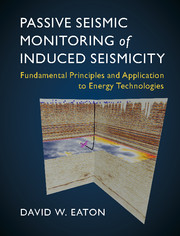 Passive Seismic Monitoring of Induced Seismicity
Passive Seismic Monitoring of Induced Seismicity Book contents
- Frontmatter
- Contents
- Preface
- List of Symbols
- Part I Fundamentals of Passive Seismic Monitoring
- 1 Constitutive Relations and Elastic Deformation
- 2 Failure Criteria and Anelastic Deformation
- 3 Seismic Waves and Sources
- 4 Stress Measurement and Hydraulic Fracturing
- Part II Applications of Passive Seismic Monitoring
- Appendix A Glossary
- Appendix B Signal-Processing Essentials
- Appendix C Data Formats
- References
- Index
1 - Constitutive Relations and Elastic Deformation
from Part I - Fundamentals of Passive Seismic Monitoring
Published online by Cambridge University Press: 07 June 2018
- Frontmatter
- Contents
- Preface
- List of Symbols
- Part I Fundamentals of Passive Seismic Monitoring
- 1 Constitutive Relations and Elastic Deformation
- 2 Failure Criteria and Anelastic Deformation
- 3 Seismic Waves and Sources
- 4 Stress Measurement and Hydraulic Fracturing
- Part II Applications of Passive Seismic Monitoring
- Appendix A Glossary
- Appendix B Signal-Processing Essentials
- Appendix C Data Formats
- References
- Index
Summary
In the beginning, God said let the four-dimensional divergence of an antisymmetric second-rank tensor equal zero … and there was light.
Michio Kaku (The Universe in a Nutshell, 2012)Constitutive relations provide a foundation upon which to construct a theoretical framework for the response of a system to external stimuli. Formally, a constitutive relation defines the mathematical relationship between physical quantities that determine the response of a given material to applied forces (Macosko, 1994). In general, constitutive relations are based on experimental observation or mathematical reasoning other than a fundamental conservation equation (Pinder and Gray, 2008). This chapter deals primarily with a particular constitutive relationship that applies to elastic media; this relationship, known as the generalized Hooke's Law, describes a linear deformation regime in which the response to applied forces is fully recoverable and proportional to the magnitude of the net force. Countless experimental results confirm the applicability of this relationship to Earth materials when subject to small strains. As outlined in subsequent chapters, combining this constitutive relation with a few basic physical principles and boundary conditions leads to a remarkable wealth of wave-propagation phenomena.
As well as a description of the constitutive relations for an anisotropic elastic continuum, this chapter provides a brief introduction to various effective-medium theories that can be used to represent a complex medium with models that are more easily described and characterized. The types of media considered are of particular interest for investigations of reservoir processes and induced seismicity in sedimentary basins, including multiphase materials, vertically inhomogeneous (stratified) media and fractured elastic media. In addition, constitutive relationships for a poroelastic medium are introduced. This type of medium has two components: an elastic frame, plus a network of fluid-filled pores. A mathematical framework is also briefly introduced that governs the diffusion of pore-pressure in a poroelastic medium.
Stress and Strain
Forces that operate in Earth's interior drive a variety of deformation processes. The net internal force per unit area that acts at a point x on an arbitrary surface within a medium is called the traction, denoted by the vector T(x) (Figure 1.1). The surface on which this is defined may not necessarily correspond with a boundary, like a fracture or bedding plane.
- Type
- Chapter
- Information
- Passive Seismic Monitoring of Induced SeismicityFundamental Principles and Application to Energy Technologies, pp. 3 - 28Publisher: Cambridge University PressPrint publication year: 2018


